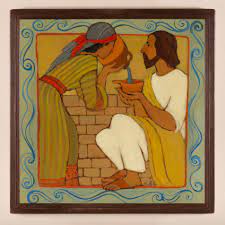
Longing for Wholeness
Yesterday's message on the woman at the well in John 4 was the last in a series on the Nameless in the Gospels. I preached this sermon "in character" as the woman to help us to think more deeply about who she was, what her struggles might be and how she might have felt about this encounter. You may watch the full video here if you like.
In brief, I believe she represents a part of all of us that longs for wholeness. We want to be seen, to have our struggles understood and accepted, and to be loved regardless of what we've been through or what we've done. While she arrives at the well to draw real water for her physical survival, Jesus offers her "living water" to revive her soul, to bring her life again as a beloved child of God. He sees her, speaks to her (though this should have been forbidden) and shares something with her that he hasn't shared with anyone else at this point in John's gospel. He tells her that he is the Messiah, the one who will bring peace. He offers her conversations, acceptance, trust and compassion. In doing so she sees the path to wholeness laid out in front of her. I'm sure she sits at his feet for the two days that follow, learning and growing closer to the Divine Presence.
What we don't know is what happens when Jesus moves on. We each face this challenge when we find a place, a person, or a community that helps us to feel more whole. The time together must end, so how do we hold onto that feeling of worthiness, love, belonging, and peace? How do we carry the living water with us? Do we need a jug? No, the answer for us all is that it has been within us all the time, we simply need to look.
How sad that, while this is Jesus' longest conversation with anyone in the gospels, this woman remains nameless, branded simply as a Samaritan woman who has had five husbands. Truly, she is us and we are her.
Love & Light!
Kaye



